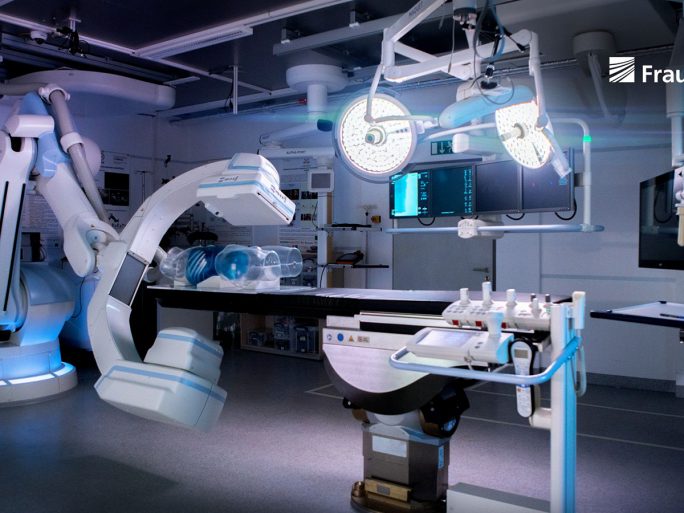Cross-Site Use of AI in the Operating Room

A pioneering Franco-German project has developed hybrid operating rooms that leverage 5G networks and artificial intelligence (AI) to enable innovative medical applications.
Imagine an emergency requiring a complex surgery, but the nearest specialist is hundreds of kilometers away. Today, this distance could be life-threatening, but in the near future, surgeons may perform such operations remotely, aided by a robot with haptic feedback technology.
A hospital’s 5G network would provide the low-latency connection needed for real-time data exchange during the procedure. A recent interdisciplinary project, involving German and French researchers, explored this and other groundbreaking possibilities.
“Under economic pressure, hospitals need to build efficient infrastructures and processes and find digital ways to network and exchange data,” says project manager Johannes Horsch from the Fraunhofer Institute for Manufacturing Engineering and Automation (IPA). “The Franco-German 5G-OR project, which brings together public and industrial research, addresses both of these challenges.” The project is funded by Germany’s Federal Ministry for Economic Affairs and Climate Protection.
Hybrid Operating Rooms and Healthcare Challenges
The researchers designed their project in response to the increasing financial pressure on German hospitals, citing a recent survey by Roland Berger: seven out of ten German hospitals ended the past year with losses. Besides consolidating services and modernizing infrastructure, many hospitals view partnerships and mergers as essential for financial sustainability. Another significant challenge is the shortage of medical and nursing staff, adds Fraunhofer IPA.
The completed research project united engineers, entrepreneurs, surgeons, and anesthetists from Berlin, Mannheim, and Strasbourg. Together, they developed three high-tech operating rooms with intraoperative imaging systems. Project partners included Fraunhofer IPA, Institut Hospitalo-Universitaire (IHU) in Strasbourg, Charité Berlin, Reutlingen University, and companies such as SectorCon and Karl Storz, as well as the French research and technology institute b<>com and the start-up Rhythm Diagnostic Systems (RDS).
“The team’s main goals are to reduce surgical complications and optimize workflows in operating rooms. Medical errors still occur in 8-12% of all hospital stays,” Horsch emphasizes. “With 5G, we can enable secure, flexible, and reliable wireless communication, allowing data exchange to operate like a high-performance highway. This connectivity reduces errors and increases efficiency.”
AI-Enhanced Applications in the Operating Room
The project has demonstrated four AI-driven applications that showcase how 5G-OR technology can reshape surgical procedures:
- AI-Supported Vital Data Monitoring: Patients wear an intelligent patch throughout their treatment journey—from surgery to aftercare at home. This patch’s sensors track vital signs, transmitting the data wirelessly to a platform monitored by AI, allowing early detection of potential complications. The 5G-OR project creates a foundation for high-frequency data processing in real time, advancing the use of AI in healthcare.
- AI-Supported Surgical Data Analysis: During surgery, AI analyzes endoscopic images, video feeds, and data from surgical instruments, helping assess the progress of the procedure and identify anomalies. This technology optimizes operating room workflows and supports real-time, data-driven decision-making. “Real-time processing of multimodal data sets will revolutionize patient monitoring, especially during anesthesia in the OR,” says Prof. Sascha Treskatsch, Clinic Director at Charité.
- Robot-Assisted Telesurgery: In high-tech operating rooms, surgeons can perform remote procedures using robots with haptic feedback. The 5G network ensures high bandwidth and low latency for the vast amounts of data needed during remote surgery, enabling specialists to operate in emergencies even when not on-site. This system can also help protect medical staff from hazards, such as radiation or infection, by allowing them to operate remotely.
- Mobile Robotic Support in the OR: A mobile robot, specifically developed for the operating room, transports medical materials and instruments, relieving staff of logistical tasks during surgery. What is common in factories—automated transport—requires exceptional precision and reliability in an OR setting, which 5G campus networks ensure with real-time data transmission.
Looking Ahead
The next step is to transfer these applications into clinical practice. This will involve extensive testing, navigating medical regulatory approvals, and finding pathways to market through industrial partnerships and start-ups. The project team also plans to broaden its network, seeking user feedback and strengthening international cooperation.
This Franco-German project illustrates how technology like 5G and AI can transform operating rooms, creating safer, more efficient environments that can ultimately save lives.